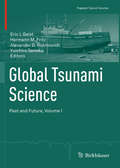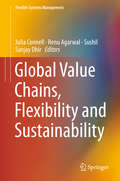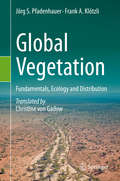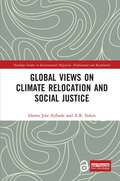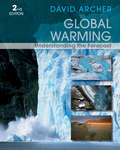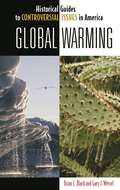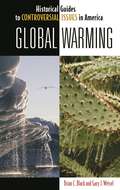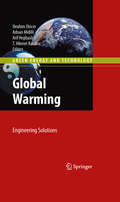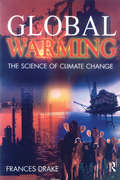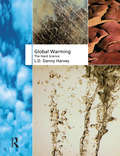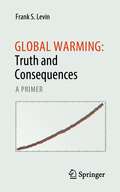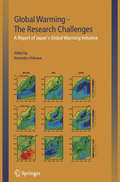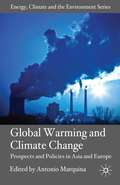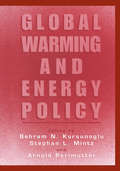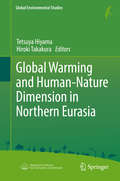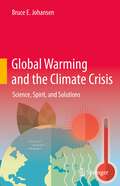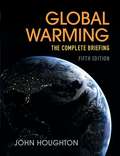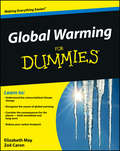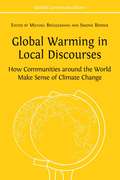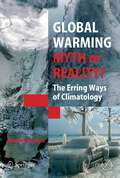- Table View
- List View
Global Tsunami Science: Past and Future, Volume I (Pageoph Topical Volumes)
by Eric L Geist Hermann M. Fritz Alexander B. Rabinovich Yuichiro TaniokaTsunami science has evolved significantly since the occurrence of two of the most destructive natural disasters in recent times: the 26 December 2004 Sumatra tsunami that killed about 230,000 people along the coasts of 14 countries in the Indian Ocean and the 11 March 2011 Tohoku (Great East Japan) tsunami that killed almost 20,000 people and destroyed the Fukushima Daiichi nuclear power plant. As a result of these and many other destructive tsunamis that have occurred over just the last decade, scientists from around the world have come together to engage in tsunami research. The global community of researchers has also expanded by discipline, adapting advances in other sciences to study all aspects of tsunami hydrodynamics, detection, generation, and probability of occurrence. The papers presented in this first of two topical volumes of Pure and Applied Geophysics reflect the state of tsunami science during this time. Nine papers examine various aspects of tsunami hazard and risk assessment. Five papers present new methods for tsunami warning and detection and six other papers describe new methods for understanding tsunami hydrodynamics. The final five papers of the volume describe tsunamis generated by non-seismic sources and important case studies. Collectively, this volume highlights contemporary trends in global tsunami science, both fundamental and applied toward hazard assessment and mitigation. The volume is of interest to scientists and practitioners involved in all aspects of tsunamis from source processes to coastal impacts. Postgraduate students in geophysics, oceanography and coastal engineering – as well as students in the broader geosciences, civil and environmental engineering – will also find the book to be a valuable resource, as it combines recent case studies with advances in tsunami science and natural hazards mitigation.
Global Value Chains, Flexibility and Sustainability (Flexible Systems Management)
by Julia Connell Renu Agarwal Sushil Sanjay DhirThis book provides a conceptual framework of global value chains, flexibility and sustainability, supported by research projects, case applications and models in various related areas organized into three parts. In the first part of the book, various authors discuss how to improve the efficiency and effectiveness of global value chains through various types of analyses. While the focus is on cluster management, and mergers and joint ventures, the legal aspects of control and liability concerning the integration of value chains, is also examined in one of the contributions. The second part includes chapters concerning ‘Strategy and Flexibility’. Strategies concern topics such as inventory management, talent management, strategic alignment, decision making, behavioural change and HR systems. The third and final part of the volume concerns the topic of ‘Sustainability’, wherein the contributions focus on various initiatives intended to promote sustainability across respective value chains bearing in mind the concept of flexibility. The book is a valuable resource for a varied audience, ranging from management students and researchers, to practicing business managers, as well as for professional institutions, consultants, and corporate organizations.
Global Vegetation: Fundamentals, Ecology and Distribution
by Jörg S. Pfadenhauer Frank A. KlötzliThis up-to-date textbook of global vegetation ecology, which comprises the current state of knowledge, is long overdue and much-needed. It is a translation of the textbook “Vegetation der Erde” (Springer-Spektrum, Heidelberg). A short introductory chapter deals with the fundamentals of vegetation ecology that are of importance for the delimitation and characterization of the global vegetation presented in this book (chorology, evolution of plants, physiognomic and structural characteristics, phytodiversity and the human impact on it as well as general terminology concerning both plant growth forms and on vegetation structure types). In the following chapters the zonal and azonal vegetation from the tropics to the polar regions including high mountains is described and discussed. The main focus is on the characterization of interactions between the spatial location of plants and plant communities on the one hand and site conditions, historic and genetic processes, spatial and temporal patterns, ecophysiology and anthropogenic influences on the other hand. Additional information on specific topics is provided in 51 boxes.
Global Views on Climate Relocation and Social Justice: Navigating Retreat (Routledge Studies in Environmental Migration, Displacement and Resettlement)
by Idowu Jola Ajibade A. R. SidersThis edited volume advances our understanding of climate relocation (or planned retreat), an emerging topic in the fields of climate adaptation and hazard risk, and provides a platform for alternative voices and views on the subject. As the effects of climate change become more severe and widespread, there is a growing conversation about when, where and how people will move. Climate relocation is a controversial adaptation strategy, yet the process can also offer opportunity and hope. This collection grapples with the environmental and social justice dimensions from multiple perspectives, with cases drawn from Africa, Asia, Australia, Oceania, South America, and North America. The contributions throughout present unique perspectives, including community organizations, adaptation practitioners, geographers, lawyers, and landscape architects, reflecting on the potential harms and opportunities of climate-induced relocation. Works of art, photos, and quotes from flood survivors are also included, placed between sections to remind the reader of the human element in the adaptation debate. Blending art – photography, poetry, sculpture – with practical reflections and scholarly analyses, this volume provides new insights on a debate that touches us all: how we will live in the future and where? Challenging readers’ pre-conceptions about planned retreat by juxtaposing different disciplines, lenses and media, this book will be of great interest to students and scholars of climate change, environmental migration and displacement, and environmental justice and equity.
Global Views on Climate Relocation and Social Justice: Navigating Retreat (Routledge Studies in Environmental Migration, Displacement and Resettlement)
by Idowu Jola Ajibade A. R. SidersThis edited volume advances our understanding of climate relocation (or planned retreat), an emerging topic in the fields of climate adaptation and hazard risk, and provides a platform for alternative voices and views on the subject. As the effects of climate change become more severe and widespread, there is a growing conversation about when, where and how people will move. Climate relocation is a controversial adaptation strategy, yet the process can also offer opportunity and hope. This collection grapples with the environmental and social justice dimensions from multiple perspectives, with cases drawn from Africa, Asia, Australia, Oceania, South America, and North America. The contributions throughout present unique perspectives, including community organizations, adaptation practitioners, geographers, lawyers, and landscape architects, reflecting on the potential harms and opportunities of climate-induced relocation. Works of art, photos, and quotes from flood survivors are also included, placed between sections to remind the reader of the human element in the adaptation debate. Blending art – photography, poetry, sculpture – with practical reflections and scholarly analyses, this volume provides new insights on a debate that touches us all: how we will live in the future and where? Challenging readers’ pre-conceptions about planned retreat by juxtaposing different disciplines, lenses and media, this book will be of great interest to students and scholars of climate change, environmental migration and displacement, and environmental justice and equity.
Global Warming: Understanding the Forecast
by David ArcherBased on the author's highly successful undergraduate course taught at the University of Chicago, Global Warming presents the processes of climate change and climate stability. Drawing on a wide range of disciplines, this Second Edition not only summarizes scientific evidence, but also presents economic and political issues related to global warming.
Global Warming (Historical Guides to Controversial Issues in America)
by Brian C. Black Gary J. WeiselTracing scientific ideas about the structure of Earth, Global Warming creates an intellectual portrait of the shifts in thinking that have led to the current controversy, enabling readers to make up their own minds on this important issue.Global Warming takes one of the hot-button issues of our time and surveys it in historical context, creating an intellectual portrait of the multi-century shifts in thinking that have led to gradual acceptance of the concept. The book summarizes pertinent aspects of geology, earth science, and climate science in easy-to-read terms. It then frames this background in terms of cultural and social shifts, including the Industrial Revolution, conspicuous consumption, and modern environmentalism. In addition, a study of the ebb and flow of cultural and political reception relates the issue to religious and social ideas.The information presented here will enable the reader to understand the scientific case stating that human activity has caused an unprecedented warming in the late 20th and early 21st centuries. Technical and political objections to this thesis are also covered, so that readers may form their own opinions on this critical subject.
Global Warming (Historical Guides to Controversial Issues in America)
by Brian C. Black Gary J. WeiselTracing scientific ideas about the structure of Earth, Global Warming creates an intellectual portrait of the shifts in thinking that have led to the current controversy, enabling readers to make up their own minds on this important issue.Global Warming takes one of the hot-button issues of our time and surveys it in historical context, creating an intellectual portrait of the multi-century shifts in thinking that have led to gradual acceptance of the concept. The book summarizes pertinent aspects of geology, earth science, and climate science in easy-to-read terms. It then frames this background in terms of cultural and social shifts, including the Industrial Revolution, conspicuous consumption, and modern environmentalism. In addition, a study of the ebb and flow of cultural and political reception relates the issue to religious and social ideas.The information presented here will enable the reader to understand the scientific case stating that human activity has caused an unprecedented warming in the late 20th and early 21st centuries. Technical and political objections to this thesis are also covered, so that readers may form their own opinions on this critical subject.
Global Warming: Engineering Solutions (Green Energy and Technology #33)
by Ibrahim Dincer Adnan Midilli Arif Hepbasli T. Hikmet KarakocGlobal Warming: Engineering Solutions goes beyond the discussion of what global warming is, and offers complete concrete solutions that can be used to help prevent global warming. Innovative engineering solutions are needed to reduce the effects of global warming. Discussed here are proposed engineering solutions for reducing global warming resulting from carbon dioxide pollution, poor energy and environment policies and emission pollution. Solutions discussed include but are not limited to: energy conversion technologies and their advantages, energy management and conservation, energy saving and energy security, renewable and sustainable energy technologies, emission reduction, sustainable development; pollution control and measures, policy development, global energy stability and sustainability.
Global Warming
by Frances DrakeFirst published in 2000. Routledge is an imprint of Taylor & Francis, an informa company.
Global Warming: The Science Of Climate Change (A\hodder Arnold Publication)
by Frances DrakeFirst published in 2000. Routledge is an imprint of Taylor & Francis, an informa company.
Global Warming
by L. D. HarveyGlobal Warming: The Hard Science presents a comprehensive, qualitatively rigorous, and critical discussion of the science underlying the global warming issue. The major processes in the climate system needed to understand projected human-induced climatic change are presented in detail. Observational systems used to monitor changes in the climate system and the ways in which the raw data are analyzed in order to produce estimates of current trends are also critically reviewed. The author discusses the hierarchy of computer models used to project changes in the carbon cycle, in climate, and in sea level and examines the physical principles underlying the greenhouse effect and projected warming. The text also presents a detailed discussion of the carbon cycle, of climate sensitivity, and of projected patterns of climatic change through time. Sea level rise and issues of risk and potential surprises are also critically assessed. Emphasis is placed throughout on developing an intuitive understanding of those results that do not depend on the details of any one computer simulation model. A series of boxes illustrate the key points through step-by-step calculations.
Global Warming
by L. D. HarveyGlobal Warming: The Hard Science presents a comprehensive, qualitatively rigorous, and critical discussion of the science underlying the global warming issue. The major processes in the climate system needed to understand projected human-induced climatic change are presented in detail. Observational systems used to monitor changes in the climate system and the ways in which the raw data are analyzed in order to produce estimates of current trends are also critically reviewed. The author discusses the hierarchy of computer models used to project changes in the carbon cycle, in climate, and in sea level and examines the physical principles underlying the greenhouse effect and projected warming. The text also presents a detailed discussion of the carbon cycle, of climate sensitivity, and of projected patterns of climatic change through time. Sea level rise and issues of risk and potential surprises are also critically assessed. Emphasis is placed throughout on developing an intuitive understanding of those results that do not depend on the details of any one computer simulation model. A series of boxes illustrate the key points through step-by-step calculations.
Global Warming: A Primer
by Frank S. LevinGlobal Warming: Truth and Consequences is a guidebook for persons who are unfamiliar with the relevant details but want to know what anthropogenic global warming and its repercussions entail. The first chapter presents background material on the earth’s climate system and some of the global warming rejecters’ claims and their refutations, including the evidence underlying the reality of anthropogenic global warming. The next chapter examines in detail many of the global warming’s contemporaneous and deleterious repercussions, while the final one considers some future scenarios and their likely consequences, some of which are from the latest IPCC Reports. It also presents a number of the proposed steps to avoid these consequences and the problems of implementing them.
Global Warming — The Research Challenges: A Report of Japan’s Global Warming Initiative
by Atsunobu IchikawaOf interest to both researchers and policy makersSuitable for course use
Global Warming and Climate Change: Prospects and Policies in Asia and Europe (Energy, Climate and the Environment)
by A. MarquinaThis compendium looks at Asian and European policies for dealing with climate change, and possible impacts on conflicts and security. It clarifies the impacts of climate change on natural resources, on the frequency and expansion of natural disasters and the repercussions for environmentally-induced migration.
Global Warming and Energy Policy
by Behram N. Kursunogammalu Stephan L. Mintz Arnold PerlmutterThe first part of the conference explores two major environmental concerns that arise from fuel use: (1) the prospect that the globe will become warmer as a result of emissions of carbon dioxide, and (2) the effect upon health of the fine particles emitted as combustion products. The conference focused on the fact that there was lack of data direct enough to enable us to predict an entirely satisfactory result, and that makes policy options particularly difficult. With regard to (1) above, in the second half of the 20th century there were major increases in anthropogenic C02 emissions, and it is generally agreed that these were responsible for an increase in C02 concentrations. But the relationship between global temperature and CO2 concentrations remains murky. The principal problem is that water vapor is a more important greenhouse gas than C02 and that the concentrations of water vapor vary widely in time and space. The approach to this problem is probably, but not certainly, a positive feedback effect: as temperature increases so does the water vapor leading to further temperature increases. Scientists associated with the Intergovernmental Panel on Climate Change (IPCC) tend to believe the general features of the models. Other scientists are often less convinced.
Global Warming and Human - Nature Dimension in Northern Eurasia: Nature Dimension In Northern Eurasia (Global Environmental Studies)
by Tetsuya Hiyama Hiroki TakakuraThis book describes the current environmental changes due to global warming in northern Eurasia, especially focusing on eastern Siberia. Spring flooding, ice-jam movements, and monitoring using remote sensing are included. Additionally, current reindeer herding of indigenous peoples in Siberia and related environmental changes such as waterlogging, rising temperatures, and vegetation changes are addressed. As a summary, the book also introduces readers to adaptation strategies at several governmental levels.The book primarily focuses on 1) introducing readers to global warming and human-nature dynamics in Siberia, with special emphasis on humidification of the region in the mid-2000s, and 2) describing social adaptation to the changing terrestrial ecosystem, with an emphasis on water environments. Adaptation strategies based on vulnerability assessments of environmental changes in northern Eurasia are crucial topics for intergovernmental organizations, such as the IPCC (Intergovernmental Panel on Climate Change). Thus, the book offers a valuable resource not only for environmental researchers but also for several stakeholders regarding global environmental change.
Global Warming and the Climate Crisis: Science, Spirit, and Solutions
by Bruce E. JohansenThis textbook introduces readers to basic scientific principles of climate change. Based on extensive empirical evidence, it explains weather events that indicate climate change’s evolution and presents important topics connected to climate change, such as political controversies, climate policy, as well as Native American perspectives. Finally, it presents attempted solutions, including policy recommendations and technological proposals for necessary changes in our world.Providing a well-written and easy-to-follow overview of knowledge of science-based geophysical facts, including thermodynamics, the book puts a strong emphasis on why expeditious action on global warming is urgent. The book also explains why smart greenhouse-gas reduction strategies will ignite economic growth, generate new domestic jobs, protect public health, and strengthen energy security.Not assuming a scientific background on the part of the reader, Global Warming and the Climate Crisis: Science, Spirit, and Solutions offers an ideal supplemental reading in many types of courses in Earth sciences, climate policy, climate change sciences, as well as politics of climate change, from high school through undergraduate. General readers also will benefit from its treatment of this very important and timely issue.
Global Warming: The Complete Briefing (Fifth Edition) (PDF) (400MB+)
by John Houghton400MB + Please request from bookshare - see attached instructions. How much of global warming is due to human activities? How far will it be possible to adapt to changes of climate? Sir John Houghton's definitive, full colour guide to climate change answers these questions and more by providing the best and latest information available, including the latest IPCC findings. The simple, logical flow of ideas gives an invaluable grounding in the science, as well as the physical and human impacts of climate change, for undergraduate students across a wide range of disciplines. Accessible to both scientists and non-scientists, the text avoids mathematical equations and includes more technical material in boxes, while simple figures help students to understand the conclusions the science leads to without being overwhelmed by vast amounts of data. Questions for students to consider and test their understanding are included in each chapter, along with carefully selected further reading to expand their knowledge.
Global Warming For Dummies
by Elizabeth May Zoe CaronGet positive suggestions for practical solutions to this heated issue. Hotly debated in the political arena and splashed across the media almost 24/7, global warming has become the topic of the moment. Whatever one's views on its cause, there is no denying that the earth's climate is changing, and people everywhere are worried. Global Warming For Dummies sorts out fact from fiction, explaining the science behind climate change and examining the possible long-term effects of a warmer planet. This no-nonsense yet friendly guide helps you explore solutions to this challenging problem, from what governments and industry can do to what you can do at home and how to get involved.
Global Warming For Dummies
by Elizabeth May Zoe CaronGet positive suggestions for practical solutions to this heated issue. Hotly debated in the political arena and splashed across the media almost 24/7, global warming has become the topic of the moment. Whatever one's views on its cause, there is no denying that the earth's climate is changing, and people everywhere are worried. Global Warming For Dummies sorts out fact from fiction, explaining the science behind climate change and examining the possible long-term effects of a warmer planet. This no-nonsense yet friendly guide helps you explore solutions to this challenging problem, from what governments and industry can do to what you can do at home and how to get involved.
Global Warming - The Greenhouse Effect (tactile)
by RnibThis simple diagram illustrates the greenhouse effect, showing how the sun's heat energy enters the atmosphere and gets trapped inside.
Global Warming in Local Discourses: How Communities around the World Make Sense of Climate Change (Global Communications #1)
by Michael Brüggemann and Simone RödderGlobal news on anthropogenic climate change is shaped by international politics, scientific reports and voices from transnational protest movements. This timely volume asks how local communities engage with these transnational discourses. The chapters in this volume present a range of compelling case studies drawn from a broad cross-section of local communities around the world, reflecting diverse cultural and geographical contexts. From Greenland to northern Tanzania, it illuminates how different understandings evolve in diverse cultural and geographical contexts while also revealing some common patterns of how people make sense of climate change. Global Warming in Local Discourses constitutes a significant, new contribution to understanding the multi-perspectivity of our debates on climate change, further highlighting the need for interdisciplinary study within this area. It will be a valuable resource to those studying climate and science communication; those interested in understanding the various roles played by journalism, NGOs, politics and science in shaping public understandings of climate change, as well as those exploring the intersections of the global and the local in debates on the sustainable transformation of societies.
Global Warming - Myth or Reality?: The Erring Ways of Climatology (Springer Praxis Books)
by Marcel LerouxThis book seeks to separate fact from fiction in the global-warming debate. The author begins by describing the history of the Intergovernmental Panel on Climate Change (IPCC) and many other conferences, and their dire predictions on global temperatures, rainfall, weather and climate, while highlighting confusion and sensationalism media reports. He then lays out the "heretical" scientific case of the sizable skeptical scientific community who challenge the accepted wisdom.
